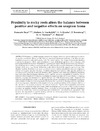Identificador persistente para citar o vincular este elemento:
https://accedacris.ulpgc.es/handle/10553/49596
| Title: | Proximity to rocky reefs alters the balance between positive and negative effects on seagrass fauna | Authors: | Tuya, Fernando Vanderklift, Mathew A. Hyndes, G. A. Wernberg, T. Thomsen, M. S. Hanson, C. |
UNESCO Clasification: | 240119 Zoología marina 250501 Biogeografía |
Keywords: | Cross-habitat exchanges Gastropods Habitat connectivity Predation Supply-side processes, et al |
Issue Date: | 2010 | Publisher: | 0171-8630 | Journal: | Marine Ecology - Progress Series | Abstract: | Proximity to habitat margins can alter the balance between positive and negative forces on species abundance. Based on this idea we examined abundance patterns of herbivorous gastropods in seagrasses adjacent to rocky reefs. We tested whether the balance between the intensity of predation (negative effect) and recruitment of new individuals (positive effect) changes with increasing distance from reefs. Abundances of gastropods varied with distance to reefs, but the direction of changes in abundance was taxon-specific: some taxa decreased in abundance with increasing distance from reefs (e.g. Pyrene bidentata), while others showed the opposite pattern (e.g. Cantharidus lepidus). Predators were more abundant on reefs and in immediately adjacent seagrasses, relative to seagrass meadow interiors. Predation intensity on 2 species with opposite patterns of abundance with proximity to reefs (P. bidentata and C. lepidus) was consistently higher in seagrasses near reef edges than in seagrass interiors, and C. lepidus was more susceptible to predation than P. bidentata. Recruitment of P. bidentata was higher in seagrasses adjacent to reefs relative to seagrass interiors, whereas recruitment of C. lepidus did not vary with distance from reefs. Dispersal of P. bidentata individuals from reefs probably explains the greater recruitment of P. bidentata at seagrass edges relative to interiors; this compensates for losses due to predation, thereby enabling high abundance in seagrasses adjacent to reefs despite suffering greater predation at this distance relative to the interiors of the seagrass meadows. In contrast, losses of C. lepidus due to predation reduced its abundance in seagrasses adjacent to reefs, while recruitment was invariant, so this species was most abundant in seagrass meadow interiors. Thus, proximity to habitat margins affected abundance patterns by influencing mortality (predation) and replenishment (recruitment) of populations. This balance was dependent on species identity, and led to contrasting patterns of abundance among species with proximity to habitat interfaces. | URI: | https://accedacris.ulpgc.es/handle/10553/49596 | ISSN: | 0171-8630 | DOI: | 10.3354/meps08516 | Source: | Marine Ecology Progress Series [ISSN 0171-8630], v. 405, p. 175-186 |
| Appears in Collections: | Artículos |
Items in accedaCRIS are protected by copyright, with all rights reserved, unless otherwise indicated.
